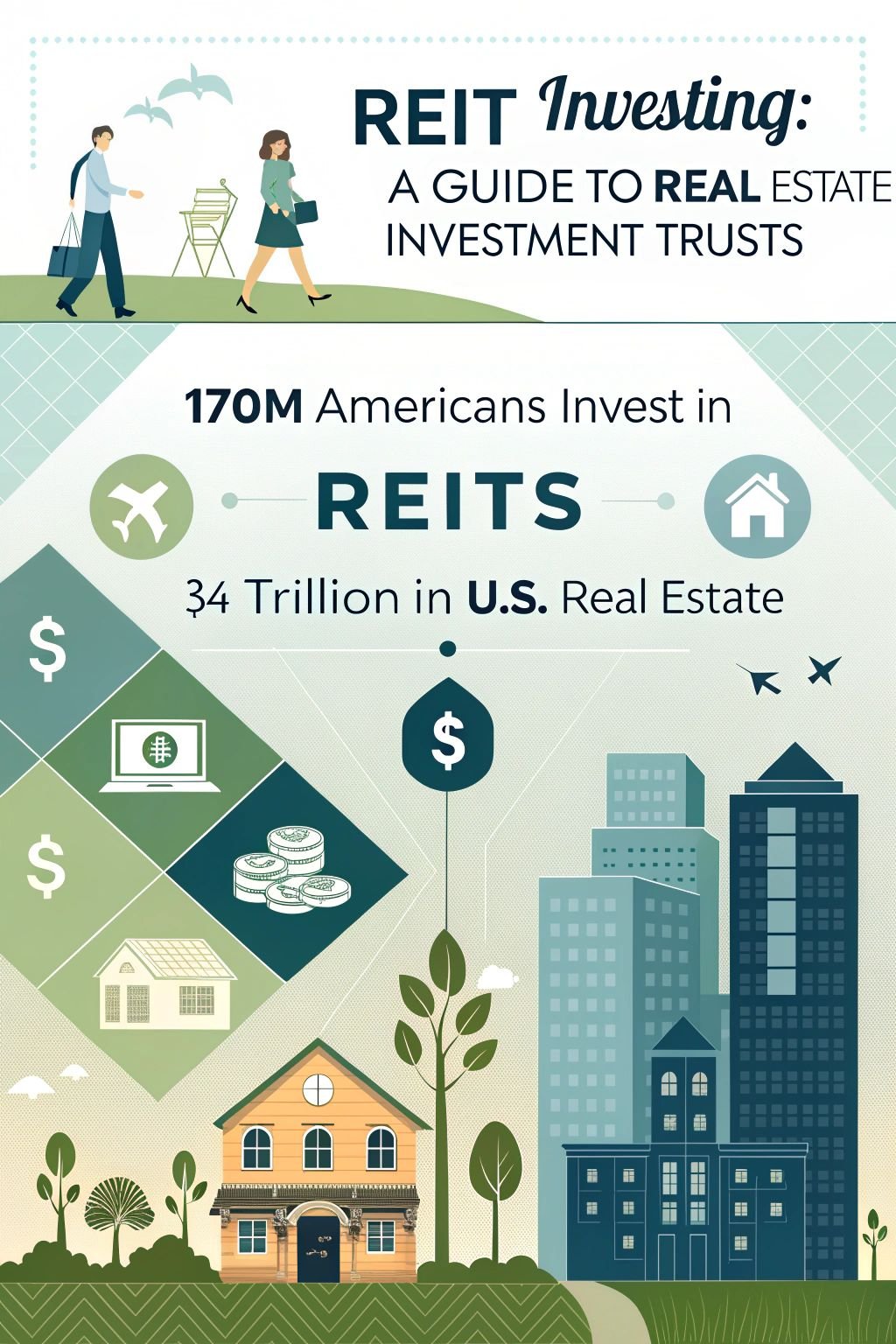Are you looking to grow your money but not sure where to start? Investing in real estate can seem tough. Owning property means dealing with tenants and repairs. It’s a lot to handle if you’re new to investing.
REIT real estate investments offer a simple way to invest in real estate without the hassle. Did you know that over 170 million Americans use REITs in their retirement accounts? 1 This guide will show you what REITs are, how they work, and how you can start investing.
Let’s explore how REITs can fit into your investment plan.
Key Takeaways
- Over 170 million Americans invest in REITs through 401(k)s, IRAs, and pensions.
- REITs own more than $4 trillion in U.S. real estate, with public REITs holding about $2.5 trillion.
- REITs must pay out at least 90% of their taxable income as dividends, often 100%, providing steady income.
- There are three types of REITs: Equity (96% of the market), Mortgage (4%), and Hybrid.
- REITs offer diversification and high dividends but can be affected by market swings and interest rates.

What is a Real Estate Investment Trust (REIT)?

REITs are companies that own or finance income-producing real estate. They manage properties like shopping centers, data centers, cell towers, and office buildings. In the U.S., REITs own over $4 trillion in real estate assets.
Public REITs alone hold about $2.5 trillion. This makes them a key part of the real estate market. 1
About 170 million Americans invest in REITs through 401(k)s, IRAs, and pension plans. REITs must distribute at least 90% of their taxable income to shareholders. Many REITs give out 100% of their income as dividends.
This can provide you with steady, passive income. Investing in REITs lets you own real estate without buying property yourself. 1
“REITs make real estate investment simple and accessible for everyone.
How REITs Work

REITs let you own a piece of real estate without buying property yourself. They earn money from rent and share profits with you through dividends, making it easy to invest in income-producing buildings.
Types of properties in REIT portfolios
REITs let you invest in various property types. This helps you build a diverse real estate portfolio.
- Office Buildings: Invest in spaces where businesses work. These include skyscrapers and office parks that earn rent from companies.
- Apartment Complexes: Own multi-family homes like apartments and condos. They provide steady rental income from tenants. 2
- Retail Centers: Put money into shopping malls, strip centers, and stores. These properties earn money from retail businesses.
- Warehouses and Industrial Spaces: Invest in storage and distribution centers. They generate income by leasing space to manufacturers and retailers.
- Medical Facilities: Own hospitals, clinics, and medical offices. These properties earn rent from healthcare providers.
- Data Centers: Invest in buildings that house computer systems and data storage. They earn money by leasing space to tech companies.
- Cell Towers: Own structures that support wireless communications. They generate income by leasing space to telecom companies.
- Infrastructure: Invest in essential services like transportation hubs and utilities. These properties provide consistent rental income.
- Hotels and Resorts: Own places where people stay while traveling. They earn money from room bookings and services.
- Timberland: Invest in large areas of forested land. These properties earn income from selling timber and land appreciation.
Public REITs hold around 580,000 properties and 15 million acres of timberland in the U.S. This variety helps you diversify your investments and reduce risk. 2How REITs generate income
REITs pull in cash in two main ways. First, they collect rent from places like malls, apartment buildings, and office spaces. This steady rental income flows to investors. 3 Second, some trusts, called mortgage REITs, lend money for real estate.
They earn interest on these loans, boosting your returns. 4 Whether from rent or interest, REITs offer ways to grow your investment and provide passive income through dividends.
Types of REITs

Ever wondered how REITs can target different property types? From bustling shopping centers to cozy apartment complexes, there’s a REIT that matches your investment style.
Equity REITs
– Equity REITs own and manage properties that bring in money, like shopping centers and cell towers. They make up 96% of the REIT market in 2023. You can invest in real estate without buying a building.
Public equity REITs lead the U.S. market, owning more than $2.5 trillion in real estate assets. This means your investment is backed by a huge portfolio of properties. 5
Equity REITs are great for earning steady dividends. They have historically provided over half of their total returns through dividends. When you invest, you get a piece of rental income from these properties.
High dividend yields make Equity REITs attractive for investors looking for regular income. Plus, they help diversify your portfolio, reducing risks from other investments like stocks or bonds.
Investing in Equity REITs can be a solid part of your portfolio.
Mortgage REITs
Mortgage REITs are a type of real estate investment trust. They finance real estate by buying or creating mortgages and mortgage-backed securities. In 2023, mortgage REITs held 4% of the market share.
Unlike equity REITs that earn from renting properties, mortgage REITs generate income from interest payments. 6 This means your investment can benefit from the interest rates in the financial market.
Investing in mortgage REITs can add income-producing real estate to your portfolio. You receive regular interest income, which can help with steady cash flow. Keep in mind that mortgage REITs are sensitive to changes in interest rates.
When rates go up, your returns might increase, but rising rates can also raise borrowing costs for the REIT. Balancing mortgage REITs with other investments can enhance your portfolio diversification and potential earnings.
Hybrid REITsHybrid REITs blend equity and mortgage REITs. This mix helps you diversify your real estate investments. By owning both properties and the loans behind them, hybrid REITs spread out risk.
Since 2009, they haven’t been popular. 7 Most investors choose to focus on either equity REITs or mortgage REITs instead.
Performance Metrics for REITs

To evaluate your REIT investments, watch key indicators like dividend yields and cash flow—discover how these metrics affect your portfolio.
Key financial indicators to monitor
Monitoring the right financial indicators is key when investing in REITs. These metrics help you gauge how well your investments are performing.
- Funds from Operations (FFO): FFO shows the cash a REIT makes from its real estate activities. It excludes profits from selling properties, giving you a clear view of regular earnings.
- Adjusted Funds from Operations (AFFO): AFFO refines FFO by subtracting capital expenses. This metric reveals a REIT’s ability to sustain and grow its dividends.
- Net Asset Value (NAV): NAV estimates the total value of a REIT’s assets minus its debts. It provides a better sense of a REIT’s true market value compared to book value. 8
- Debt Levels: Many REITs use a lot of debt. Checking debt levels helps you understand the financial risk and stability of the REIT.
- Dividend Yield: This shows how much a REIT pays you each year compared to its stock price. A higher yield means more income from your investment.
- Occupancy Rates: High occupancy rates indicate steady rental income for the REIT. Low rates might signal potential income problems.
- Capitalization Rate (Cap Rate): Cap rate measures the return on a real estate investment property. It helps you compare the profitability of different REITs.
By keeping an eye on these indicators, you can make smarter decisions and build a strong real estate portfolio.
Historical performance trends
When you look at the long-term picture, REITs have really stood the test of time: 9
| Time Period | Performance Highlights |
|---|---|
| Last 45 Years | Reliable growth in dividends and property values |
| Last 20 Years | Beat the S&P 500 and kept up with inflation |
Benefits of Investing in REITs

Investing in REITs can diversify your portfolio and offer steady dividends, making them a smart choice for your financial growth—read on to learn more!
Diversification benefits
Including REITs in your investments spreads out your risk. REITs often move differently than stocks and bonds. This low correlation helps balance your portfolio. 10 They also act as an inflation hedge.
When prices go up, REITs usually increase rents and property values. This means your real estate assets can keep pace with inflation. Plus, owning REITs gives you access to income-producing real estate without buying property yourself.
This boosts your portfolio diversification and can lead to steady passive income.
Potential for steady dividends
REITs offer high dividend yields by distributing at least 90% of their taxable income. 11 This ensures you receive regular income from income-producing real estate assets like shopping centers, cell towers, and data centers.
These properties generate steady rental income, which flows to you as dividends, making REITs a reliable source of passive income.
Historically, real estate investment trusts have delivered an average annual return of 11.8%. 11 This consistency helps you build a dependable income stream. Whether you’re an investor, homeowner, or real estate agent, steady dividends from REITs can enhance your financial portfolio.
Reliable dividends also aid in portfolio diversification, boosting your overall financial stability.
Risks Associated with REIT Investing

REITs can wobble when the stock market slips or interest rates rise, so it’s wise to grasp these risks before investing – read on to learn more!
Market volatility
Market swings can affect your REIT investments. When the stock market dips, your real estate assets might lose value. 12 Economic downturns increase market volatility, making REIT valuations fluctuate.
Interest rates also play a role; rising rates can reduce rental income and dividend yields. 3 Keep an eye on these factors to manage your portfolio effectively. Understanding how market risk impacts your investments helps you make smarter financial decisions.
Interest rate sensitivityInterest rates affect how REITs perform. When rates go up, REITs pay more to borrow money. 13 This can lower their profits and the dividends you receive. Higher rates might also make bonds and other investments more attractive, drawing money away from REITs.
Keep an eye on interest rates to understand how they might impact your real estate investment trusts. Up next, we’ll explore how dividends work in REITs.
Dividends in REITs

REIT dividends can give you regular income, so read on to learn how they can enhance your portfolio!
Dividend yield analysis
Real estate investment trusts (REITs) must distribute at least 90% of their taxable earnings as dividends. 14 This rule makes their dividend yields a key feature for investors like you.
High dividend yields from REITs can provide a steady stream of passive income, similar to owning income-producing real estate. Whether you’re looking at equity REITs or mortgage REITs, the consistent payouts can help boost your investment portfolio.
Modern US equity REITs use dividend smoothing to keep their payouts stable each quarter. 14 This means you get regular dividends, even if the real estate market has its ups and downs.
Steady dividends are great for building passive income and can make your investments feel more secure. Plus, with diverse real estate assets like commercial properties or cell towers in their portfolios, REITs offer a reliable way to earn consistent income without the hassle of managing properties yourself.
Factors affecting REIT dividends
Now that you’ve looked at dividend yields, let’s explore what affects REIT dividends. Knowing these factors can help you make smarter investment choices.
- Earnings Distribution: REITs must give out at least 90% of their earnings. This rule keeps dividend yields high. When a REIT earns more, it can pay higher dividends to you. 15
- Interest Rates: Rising interest rates can make borrowing more expensive for REITs. This can squeeze their profits and lower dividends. Lower rates usually help REITs pay better dividends.
- Property Values: If the value of the real estate assets in a REIT’s portfolio goes up, rental income can increase. Higher rental income means more money for dividends.
- Occupancy Rates: High occupancy in properties means steady rental income. When more spaces are rented, REITs earn more and can distribute higher dividends.
- Debt Levels: REITs often use debt to buy properties. High debt can lead to higher interest payments, leaving less money for dividends. Keeping debt in check helps maintain healthy dividends.
- Market Conditions: A strong real estate market boosts revenues from sales and rentals. Good market conditions lead to higher dividends for investors like you.
- Management Efficiency: Effective management can maximize rental income and control costs. Good managers help ensure that dividends stay strong and reliable.
- Tax Regulations: Changes in tax laws can impact how much REITs can distribute. Favorable tax rules support higher dividend payouts, benefiting your investments.
- Rental Income Stability: Consistent rental income from properties ensures regular dividends. Stable income sources make dividends more predictable and reliable. 16
- Portfolio Diversification: A REIT with a mix of property types, like shopping centers and data centers, can reduce risks. Diversified portfolios help stabilize dividends even if one sector slows down.
Understanding these factors can give you an edge in REIT investing. Keep an eye on these elements to make informed decisions and grow your investment portfolio.
Regulatory Requirements for REITs

REITs must follow SEC rules and tax laws to keep things legit—read on to see how these regulations can impact your investments!
Qualification criteria
Investing in real estate investment trusts (REITs) can be a smart move. But first, the company must meet certain rules.
• Asset Allocation: At least 75% of the company’s assets must be in real estate, cash, or government securities. This ensures the focus stays on income-producing properties. 18
• Income Sources: 75% of the REIT’s income should come from rents, mortgage interest, or property sales. This keeps the money flowing from real estate activities.
• Dividend Payout: Companies must distribute at least 90% of their taxable income to shareholders as dividends. You get steady income from your investment. 17
• Shareholder Limits: There must be 100 or more shareholders. This spreads out ownership and reduces the risk of a single investor having too much control.
• Ownership Cap: No single shareholder can own more than 5% of the REIT. This rule helps maintain a diverse group of investors.
• Tax Requirements: The REIT must comply with specific tax regulations to maintain its status. This includes filing the right forms with the SEC.
• Operational Tests: From the second taxable year, the REIT must pass the 100 Shareholder Test and the 5/50 Test. These tests ensure the REIT remains widely owned and diversified.
Meeting these criteria helps REITs provide reliable income and maintain their attractive investment features for you.
Tax implications
REITs must distribute at least 90% of their taxable income to investors. 19 This keeps their corporate taxes low. When you invest in real estate investment trusts, you receive dividends from these distributions.
These dividends are part of your taxable income.
Good news! Qualified REIT dividends might let you take a 20% deduction. This comes from the Tax Cuts and Jobs Act of 2017. But hurry, this benefit ends in 2025. 19 Putting your REITs in tax-advantaged accounts like individual retirement accounts can also help reduce taxes.
Understanding these rules can boost your investment returns and keep more money in your pocket.
Next, let’s explore how to start investing in REITs.
How to Start Investing in REITs

Want to start with REITs? Choose between publicly traded or non-traded options and follow our easy tips—read on to get going!
Choosing between publicly traded and non-traded REITsPublicly traded REITs might be your go-to if you like easy access to your investments. They’re listed on stock exchanges, so buying and selling is a breeze. Plus, the SEC keeps an eye on them, giving you extra peace of mind.
This makes them a great fit for most investors looking to add real estate to their portfolio. 20
On the other hand, non-traded REITs are designed for accredited investors who don’t mind locking in their money for a while. They don’t have the same liquidity, which means selling your shares isn’t as simple.
If you’re comfortable with less flexibility and seek different real estate opportunities, non-traded REITs might work for you. 21 Next, let’s explore some tips to get you started with REIT investing.
Tips for first-time REIT investors
Starting your REIT investment path can be exciting and rewarding. Follow these tips to make smart choices and grow your portfolio.
- Start Small with REITs
Allocate 2-5% of your portfolio to diversified REITs. This helps you get comfortable without risking too much. - Choose REIT Funds for Diversification
Use REIT mutual funds or exchange-traded funds (ETFs) to spread your investments across different real estate assets. This reduces risk and enhances stability. - Utilize Tax-Advantaged Accounts
Invest through individual retirement accounts (IRAs) to enjoy tax benefits. This can help increase your after-tax returns. - Select the Right Type of REITs
Pick from equity REITs, mortgage REITs, or hybrid REITs based on your investment goals. Each type offers different income streams and risk levels. - Monitor Key Performance Metrics
Keep an eye on dividend yields and historical performance trends. These indicators show how well your REITs are performing. - Diversify Across Property Types
Invest in REITs that own various properties like shopping centers, data centers, and cell towers. This spreads your risk across different sectors. - Stay Informed About Market Conditions
Understand how interest rates and market volatility affect your investments. Being aware helps you make timely decisions. - Seek Professional Advice
Consult with an investment advisor to tailor your REIT strategy. They can guide you based on your financial goals and risk tolerance. - Avoid High Fees
Choose no-load REIT funds to keep your costs low. Lower fees mean more of your money works for you. - Be Patient with Your Investments
REITs are best for long-term growth. Give your investments time to generate steady dividends and appreciate in value.
Following these tips will set you on the path to successful REIT investing. Start small, stay diversified, and keep your goals in sight.
REIT Investment Strategies
Mixing different REIT types can strengthen your portfolio and balance your earnings—keep reading to discover the best strategies for your investments!
Diversifying across different types of REITs
Diversifying your REIT investments can help balance risk and increase potential returns. By spreading your investments across different REIT types, you tap into various real estate markets. 24
- Spread Across Equity, Mortgage, and Hybrid REITs
Invest in equity REITs for ownership in income-producing properties like shopping centers and data centers. Mortgage REITs provide exposure to real estate debt, offering steady income from interest. Hybrid REITs combine both equity and mortgage strategies, giving you a mix of income sources. - Include Different Property Sectors
Choose REITs that focus on various sectors such as commercial real estate, cell towers, and rental properties. This variety ensures that your portfolio isn’t tied to one specific market, reducing the impact of sector-specific downturns. - Geographic Diversity Matters
Invest in REITs that operate in multiple regions or countries. Geographic diversification protects your investments from local market fluctuations and economic issues in a single area. - Leverage Management Expertise
Select REITs managed by experienced professionals with a strong track record. Skilled managers can manage market changes and optimize real estate portfolios, enhancing your investment’s performance. - Combine Publicly Traded and Private REITs
Mix investments in publicly traded REITs with private or non-traded options. Public REITs offer liquidity through stock markets, while private REITs can provide higher yields and access to exclusive properties.
Exploring these diversification strategies sets a strong foundation for your REIT investment journey. Next, let’s explore the different types of REITs available.
Long-term vs. short-term investment approaches
Choosing a long-term investment strategy with real estate investment trusts (REITs) pays off. REITs are designed to hold properties for about 11 years. 25 Holding your investment longer can lead to higher profits and better returns.
Short-term approaches may miss out on the growth from income-producing real estate. Long-term investors can enjoy steady dividends and diversify their portfolios effectively. 26
Next, let’s explore real estate investment strategies.
Real Estate Investment Strategies
To boost your portfolio diversification, mix different types of REITs. Equity REITs focus on income-producing real estate like shopping centers and data centers. 26 Mortgage REITs invest in real estate assets by providing loans or buying debt.
Hybrid REITs combine both approaches. By spreading your investments across these types, you reduce risk and tap into various income streams.
Using strategies to increase value is key. Buying properties with low occupancy can offer growth opportunities. Renovating and improving these real estate assets makes them more attractive, raising their value and rental income.
Holding REITs in tax-advantaged accounts like IRAs helps you defer or even eliminate taxes on your dividends. This smart move can enhance your passive income and grow your retirement savings faster.
Conclusion
Jumping into REITs can boost your portfolio with diverse real estate assets like cell towers and data centers. Enjoy steady dividends while spreading your investments across different property types.
Keep an eye on key metrics to make smart choices and manage risks. Whether you’re new or experienced, REITs offer a simple way to invest in real estate without the hassle of being a landlord.
Start today and watch your investments grow!
For more detailed strategies on building your real estate portfolio, check out our guide on Real Estate Investment Strategies.
FAQs
1. What exactly are real estate investment trusts (REITs)?
Real estate investment trusts, or REITs, let you invest in income-producing real estate without buying property. They include equity REITs, which own buildings like shopping centers and data centers, and mortgage REITs, which handle real estate assets like loans.
2. How can REITs help with portfolio diversification?
REITs are great for portfolio diversification. By adding REIT mutual funds or exchange-traded funds (ETFs) to your investments, you spread risk across different real estate markets, like commercial real estate and cell towers, reducing the impact of market changes.
3. Are there different types of REITs available for investors?
Yes, there are several types. Publicly traded REITs are easy to buy through stock exchanges, while public non-traded REITs are not listed and can be less liquid. Hybrid REITs combine both equity and mortgage REIT features, offering a mix of rental income and interest from debt securities.
4. What are the tax benefits of investing in REITs?
REITs offer tax-advantaged accounts and can provide passive income through dividends. The ordinary income from REITs can be taxed differently, and some investments might qualify for tax-deferred growth, making them attractive for long-term financial planning.
5. How do REITs compare to other investment funds like mutual funds and hedge funds?
REITs differ from mutual funds and hedge funds by focusing solely on real estate. While mutual funds and ETFs can include various asset types, REITs specialize in real estate investments, offering specific benefits like rental income and exposure to the real estate market without being a landlord yourself.
6. What should I consider before investing in REITs?
Before jumping in, think about factors like dividend yields, fund managers, and the real estate market’s health. Check the SEC’s registration and be aware of any conflicts of interest. Consulting a financial adviser can help you navigate options like private REITs and ensure your investment aligns with your financial goals.
References
- ^ https://www.reit.com/what-reit
- ^ https://www.reit.com/what-reit/reit-basics
- ^ https://www.businessinsider.com/personal-finance/investing/what-is-a-reit (2024-10-11)
- ^ https://www.investopedia.com/terms/r/reit.asp (2024-07-19)
- ^ https://www.reit.com/what-reit/types-reits/guide-equity-reits
- ^ https://www.rocketmortgage.com/learn/mortgage-reits (2024-09-22)
- ^ https://www.fool.com/investing/stock-market/market-sectors/real-estate-investing/reit/hybrid-reit/ (2024-10-28)
- ^ https://www.investopedia.com/articles/04/030304.asp
- ^ https://www.mdpi.com/2071-1050/15/6/5436
- ^ https://econ.unc.edu/wp-content/uploads/sites/38/2017/09/Mayo_Ye_Song_2017.pdf
- ^ https://www.nerdwallet.com/article/investing/reit-investing
- ^ https://www.fidelity.com/learning-center/trading-investing/investing-in-REITs
- ^ https://www.researchgate.net/publication/317830157_On_the_Interest_Rate_Sensitivity_of_REITs_Evidence_from_Twenty_Years_of_Daily_Data (2024-10-22)
- ^ https://www.tandfonline.com/doi/full/10.1080/09599910903441549
- ^ https://www.dividend.com/dividend-education/the-definitive-guide-to-reits-real-estate-investment-trusts/
- ^ https://www.reit.com/sites/default/files/media/PDFs/UpdatedInvestorsGuideToREITs.pdf
- ^ https://www.reit.com/what-reit/how-form-reit
- ^ https://www.sec.gov/files/reits.pdf
- ^ https://www.investopedia.com/articles/pf/08/reit-tax.asp
- ^ https://www.fool.com/investing/stock-market/market-sectors/real-estate-investing/reit/non-traded-vs-traded-reits/
- ^ https://www.kiplinger.com/real-estate/publicly-traded-reits-vs-nontraded-reits (2023-02-19)
- ^ https://fundrise.com/education/reits-101-a-beginners-guide-to-real-estate-investment-trusts
- ^ https://www.investopedia.com/articles/mortgages-real-estate/10/real-estate-investment-trust-reit.asp
- ^ https://www.sciencedirect.com/science/article/pii/S0377042713004421
- ^ https://www.tandfonline.com/doi/abs/10.1080/08965803.2021.2001896
- ^ https://silverstarreit.com/reit-investing/



















